Are you the missing piece?
You know how important it is for lab technicians to be involved from the beginning. The more the lab technician knows and the more input he or she can provide the clinician early on, the better the outcome for the patient. After all, you are the one creating the restorations, the restorations patients are depending on to transform their smile.
You know how important it is for lab technicians to be involved from the beginning. The more the lab technician knows and the more input he or she can provide the clinician early on, the better the outcome for the patient. After all, you are the one creating the restorations, the restorations patients are depending on to transform their smile.

Clinicians are realizing more and more that treatment planning is a team effort, one that involves not only the doctor and the patient, but one that includes any necessary specialists-and that means the lab technician. But for that to happen, everyone involved has to communicate, has to be aware of everyone else’s role in the treatment planning process. Traditionally, communication is not something that comes easily for labs and doctors, but that is changing.
Today, there are technologies, some dental specific and some not, that can help bridge that communication gap. These tools ensure you get involved in the process sooner and that, in the end, the patients get the result they’re looking for without needing to come back to the dentist’s office over and over because their case needs a remake. With the advanced treatment planning tools available today, that shouldn’t be happening. Even as cases become more complex, treatment planning has become more predictable-when the right tools are used properly. From digital impressions to Web-based communication to cone beam technology, the tools are there to make treatment planning more advanced than ever before. You, and your doctors, just have to be willing to use them and embrace the emerging digital workflow.
“From the very beginning, it’s a team effort. In my position, I want good accounts and good dentists to grow my business. To do that, I can’t let doctors have bad experiences, whether they’re my fault or not,” said Daxton Grubb, President of R-dent Dental Laboratory. “My job is to minimize that. It’s important for us to get involved earlier so we don’t have to call a doctor after they have already sent us a case and tell them we need them to get the patient back in for additional bites, pictures, models, etc. Doctors count on us to minimize their losses as well. The sooner we can get in on those cases so they understand what we need, the better.”
The right treatment planning tools can help ensure you’re involved throughout the process and that everyone is happy with the final outcome. Here we break down some of the latest advancements to help make that happen.
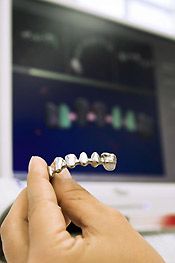
Web-based prescriptions
It happens all the time. You get a case in and the doctor wants you to use a certain material, but didn’t provide you with the information you need to make that happen. You have questions about shade, or maybe you’re working with an impression that isn’t as good as it should be. You need more information, and no matter how many messages you leave, the doctor won’t call you back.
That lack of information makes it difficult for you to do your job, but there are ways for you to get that information on the front end. Joe Procopio, President of Pro Esthetics Dental Laboratory, and some of his dentist clients use Ivoclar Vivadent’s Web-based prescription form Intercom to make sure all the information pertinent to a case is communicated from the very beginning.
How does it work? The doctor fills out the prescription right in the operatory, while the patient is there, Procopio said, and unless the doctor fills out all the information on that prescription, he can’t advance to the next step. Once everything is filled out, the doctor sends the prescription to the lab via e-mail.
This user-friendly program really has streamlined the treatment planning process, Procopio said, and has eliminated a lot of follow-up calls and trying to guess what the doctor and the patient really want.
“Everything is on there,” Procopio said. “If we’re doing an IPS e.max or an IPS Empress or a metal-free restoration and the doctor chooses that option on the form, he has to give me a stump shade, which really helps us. A lot of time that’s a forgotten part of a metal-free restoration, but it helps us determine how to exactly make that crown.”
Whenever laboratories have to make follow-up calls because of incomplete information, opportunity costs begin to rise, said Andreas Schumacher, MBA, MS, Marketing Manager,Technical Division, for Ivoclar Vivadent. Not only that, patient satisfaction declines if a case is delayed or not prepared as desired because of insufficient case information. Intercom addresses both cost drivers, forming an even stronger partnership between the lab and dentist founded on cost-effective, quality patient care.
Many doctors also use Web-based software to keep everyone informed about what’s going on in a case, said Dr. Christopher Ramsey, a practicing cosmetic dentist in Jupiter, Fla., and Dental Products Reports’ Cosmetic/Restorative Team Lead. Through Web-based software, companies such as Sesame Communications make it possible for the restorative dentist, specialists and the lab technician to go to one place for the most up-to-date information about a case, information that’s updated from everyone involved. That’s a great way to keep the team informed, especially when you’re dealing with a complex cosmetic case.
Beyond the phone call
Making a phone call to your dentist isn’t the only way you can talk about a case these days. Doctors are busy people, but it doesn’t take them that long to send an e-mail or a text from their smartphone, Grubb said. If your doctor can e-mail or text you a picture of the patient while the patient is still in the chair, you can communicate instantly about where to go with the treatment plan.
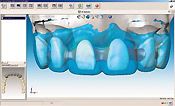
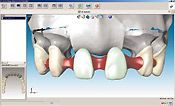
“Anything that can put us there, whether it’s a picture, webcam or whatever,” Grubb said. “Any good lab technician, when they have an understanding of where the doctor and patient wants to go and everybody is on the same page, most good labs and dentists can accomplish pretty much anything they want. When you skip steps or make assumptions, that’s when we open the door for issues and set ourselves up for failure.”
Skype video calling is a tool Edward Corrales, of Downtown Dental Designs, likes to use to enhance communication, especially when he’s about to work on a large cosmetic case. In a sense, Skype puts him in the operatory with the doctor and the patient, even though they may be on opposite coasts. He can see and even talk to the patient, which gives the lab a huge advantage when it comes to understanding the outcome that patient is after. Beyond that, patients feel more comfortable going forward with the case. They’ve now met and talked with the person who’s ultimately going to make the restoration, and they’re impressed with the effort the lab is making to get to know their case and their needs.
Webinars and online communication services such as GoToMeeting are other options that can get you closer to the doctor and the patient, said Daniel Llop, CDT, President and CEO of nSequence Center for Advanced Dentistry. Gone are the days when the dental lab technician is the last one included in treatment planning, and these technologies make that possible. You no longer have to try to guess what the patient looks like or be left in the dark about the details of a case-you have to remember you’re the one making what the patient is paying for.
“Patients buy teeth. Not radiographs, not bone grafts, not implants, not sinus lifts. Patients want to be esthetically and functionally restored with the least amount of chairtime and they want it to be feasible and they want to be out of pain,” Llop said. “And so by digitizing treatment planning and bringing all the professionals together in one digital room using GoToMeeting or webinars, there is a certain professional accountability that is achieved and an information exchange, therefore advancing the interdisciplinary knowledge within the professional community. Any time that is done, dentistry advances.”
No matter the method you use, the communication has to be there for you to feel connected to a case. If all you get is a box with a less-than-ideal impression inside and a note from the doctor to “make it work,” you’re not going to feel very vested in that case.
“It will get done but not that well because we don’t feel it. We’re not really involved. We don’t feel it in our hearts to really give 100 percent because we don’t see the final result in our mind of what everyone wants to achieve,” Corrales said. “When you do a diagnosis with a doctor via Skype or otherwise, when you see a wax up and then design it in the computer or wax and press you just did the case three times in your head, and that really helps you out with the final result.”
Digital impressions
This technology represents another huge step forward in treatment planning and communication. Doctors can send all the information from the digital impression to the lab technician while the patient is still in the chair, Procopio said. The lab tech can then say, “This is great,” or, “Hey, we need to take a new scan; I can’t make the restoration with the prep you did.” Knowing this up front saves everyone involved time and money.
The ability to see that prep in real time is huge, Grubb said, and helps eliminate a lot of problems that can come up along the way, whether you’re talking about a cosmetic case or regular dentistry. Too often, labs get impressions that the doctor thought looked OK, but they don’t always see the same thing once the lab pours the model. The digital impression gives the lab technician the ability to communicate about things like clearance, prep and margins so they can get it right the first time. These systems also provide a fully accurate bite, Grubb said, and there’s no question about whether the patient bit down properly as there always is when impression materials are involved.
Not a lot of doctors are using these systems now, but the numbers are growing, and industry experts expect that to continue. And until they catch up, if you have the capabilities to work with digital impressions, it makes your lab more attractive to other dentists, even if they’re not quite there yet, Procopio said. It puts the lab in a different light, as a lab that’s on the cutting edge and that is willing and able to go that extra step to ensure patients receive the best restorations possible.
More advanced implant systems
Making sure everyone is on the same page can be difficult when dealing with complex implant cases. There are advanced implant systems that makes it possible for everyone involved to look at the case in 3D, Grubb said. In his lab, he uses Astra Tech’s Atlantis implant system and says the 3D images of the patient’s anatomy gives them the ability to toss and turn the image and look at the abutment and the proposed restoration.
Known as Facilitate™ computer-guided implant treatment, this software helps ensure accuracy and provide more control over the esthetic outcome. And because it’s something that can be sent to all the specialists involved, it helps connect those specialists and ensure everyone is on the same page when it comes to the treatment plan.
“Atlantis is an excellent product because you can virtually do the restoration before you ever fabricate it,” said Dr. Bob Hewitt, a retired dentist who works with Grubb at R-dent Dental Laboratory. “The opportunity is overlooked so many times.”
More predictable planning
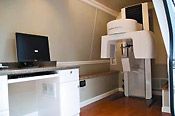

Photos courtesy of Elvin Carrero
Cone beam 3D imaging takes the guesswork out of implant placement, said Dr. Hugh Flax, President of the American Academy of Cosmetic Dentistry. This technology enables the clinician, lab technician, surgeon and even the patient to see any issues you might be dealing with before it’s time to place an implant. It shows you if there isn’t enough bone and helps you map out a plan that includes exactly where the implant needs to be placed.
Simply put, it makes treatment planning more predictable, said Elvin Carrero of Tru Imaging. Having all the information you need and creating a surgical guide before you go into surgery is huge because everyone knows what to expect.
“You can actually get the prosthesis made before you go into the surgical setting because of the cone beam CT scan,” Carrero said. “Now, you have the surgical, restorative and lab component. The triangle. All parts are communicating before we go into a surgical setting. This is our treatment plan, this is the prosthesis we’re going to make, and this is where you need to put your implant. It’s giving labs the information they need to get their job done.”
So why isn’t every doctor using this technology in practice? It’s a great planning tool, but it’s an expensive one. That’s where Carrero comes in. His company is one of the mobile imaging centers that brings cone beam to dental practices. He has a large customized van equipped with cone beam technology; what he describes as an extension of a practice. He visits practices in Tennessee and Kentucky and takes the scans on the property, making the process more convenient for the patient and the doctor.
With this becoming a viable option for many dentists, you may see these types of scans more often for more predictable planning on your end.
Presentation wax ups
When treatment planning, presentation wax ups can be a huge help to the dentist, Dr. Hewitt said. Dentists can take these lab-created visual aides and present the cases to their patients, showing them what can be done as far as rehabilitating their smile.
But that’s not all a wax up can do. When you get that approved wax up back, you have a better understanding of where the doctor and patient want to go. At R-dent they can take the wax up and scan it into their software, Grubb said. Instead of going in and saying they’re doing a Lava bridge, they’re going in and building the framework by looking at models and doing a visual fabrication. They’re actually scanning that wax up and building the framework within the wax up, giving them what Grubb describes as the perfect framework to build the wax up from.
“It’s just another way to bridge the gap for big cases. When we’re doing big cases it’s so easy for the doctor to send in a case and say ‘I want this,’ and there are so many ways to go with that,” Grubb said. “The more we can have a better understanding of what the doctor and the patient want-doing models, doing wax ups, doing temporaries from wax ups, us using the technology we have once we get the information back-I can’t imagine doing a cosmetic case without going through those steps now. Nobody understands where the doctor and patient want to go if you don’t.”
Grubb’s lab also includes silicon putty matrixes with these presentation wax ups for doctors to use as a prep guide and another one to use for temporaries. All too often, a lab will do a cosmetic wax up, the doctor will show the patient the wax up as what the lab can do, raising the patient’s expectations. The doctor does the prepping, makes the temps, and then the lab realizes the doctor didn’t give enough clearance to match the wax up, and that means the patient is disappointed with the result. Providing the doctor with a prep guide helps avoid this scenario.
“We give them the right amount of clearance and have the preps angled so the restoration will fit onto the preps,” Dr. Hewitt said. “If we make the restoration, and the restoration breaks because they didn’t give us enough clearance, then they think it’s our fault. I’ve been on both sides of it. I practiced dentistry for 40 plus years, and now I’m here, and I’ve seen stuff come in here that’s just astounding. You can tell in some instances it hasn’t been planned out. Then the lab is to blame, the finger is pointed at them. So many times it’s not the lab’s fault, but we have to eat that remake because the right restoration was not used in the right place.”
The benefits of CAD/CAM
Digital treatment planning is nothing new for Corrales who has used Sirona’s CEREC for six years. Because of what’s happened with CEREC and CEREC Connect, his lab is digitally receiving cases from doctors all over the country. They receive the files from a CEREC machine, upload them at the lab and do the restoration digitally. They can do single restoration bridges out of any material they want, as well as large veneer cases, diagnostic wax ups and even implants.
Corrales also remotely accesses doctor’s CEREC computers to see their work, making the treatment planning process that much easier.
“I can design their work on their computer, or I can retrieve their work from their computer and send it to myself for me to finish,” he said. “It’s pretty amazing what we can do. I think we’re the only ones doing that, but I’ve been presenting that concept for the last year. More and more labs will be able to offer that service, where you are designing or revising people’s work. It’s more of a service, and you’re saying to the doctor ‘I’m here for you whatever happens.’”
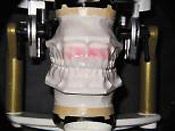
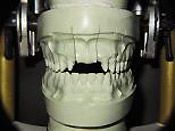
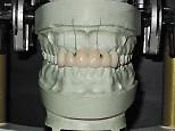
Photos courtesy of Daxton Grubb
Of the doctors who use this technology, only a very small percentage are excellent at it, Corrales said, opening up an opportunity for labs. They depend on you to speak the CAD/CAM language and to share your knowledge about the technology. Many of these doctors just know how to press the button to mill it, send it out and submit it. They don’t realize what all is possible with this technology. If you educate and market yourself the right way, these dentists will turn to you for your expertise.
“The best part is patients know about this technology now, through TV and magazines. CAD/CAM technology is here,” Corrales said. “I’m in the middle of it. I love it all. And yes I’ve had scary times here and there. You need to find your niche within the technology. You’d be amazed how much money there is to be made.”
The importance of education
Today, lab technicians are recognized as professionals, as specialists in the dental field rather than third-party vendors, Llop said. General dentists and specialists are realizing the plethora of information lab technicians have accumulated over the course of their careers, and that they’re a valuable resource in the treatment planning process. And the more education you have, the better. Learn about the other dental specialists by working with them and also by attending the courses they attend, Llop said.
“Dental lab professionals need to understand they’re going to be called on by the specialists in the dental community to become professionals quickly, so if they have not taken it upon themselves to be educated in all the specialists of dentistry, then they will quickly fall by the wayside,” he said. “As digital dentistry catches fire, these people are looking for educated dental technologists to become part of regimented treatment planning sessions.”
Your changing role
As more and more products and technologies become available, doctors are relying on their labs today more than ever. The options are coming out faster than they can keep up with, so they need to have a lab they can turn to when it comes to treatment planning and beyond. You need to be that resource.
Dr. Flax, who is thinking about adding digital impressions to his practice, plans to talk to his lab as part of his research. Grubb recently received a call from a dentist client looking for purchasing advice on the same systems. That’s the type of relationship you should have with your dentists. You should be the person they turn to for that kind of advice. That type of relationship is what leads to better treatment planning and, in the end, more successful cases.
And with all the advancements and the knowledge base lab technicians have, that’s starting to happen.
“What if you woke up one day and all the lab technicians were taken off the face of the planet?,” Llop said. “That would be a bad day in the dentist’s office. The dental lab technician is a vital professional who serves as a vital component to advanced treatment planning in this new paradigm in dentistry. And that’s digital dentistry.”